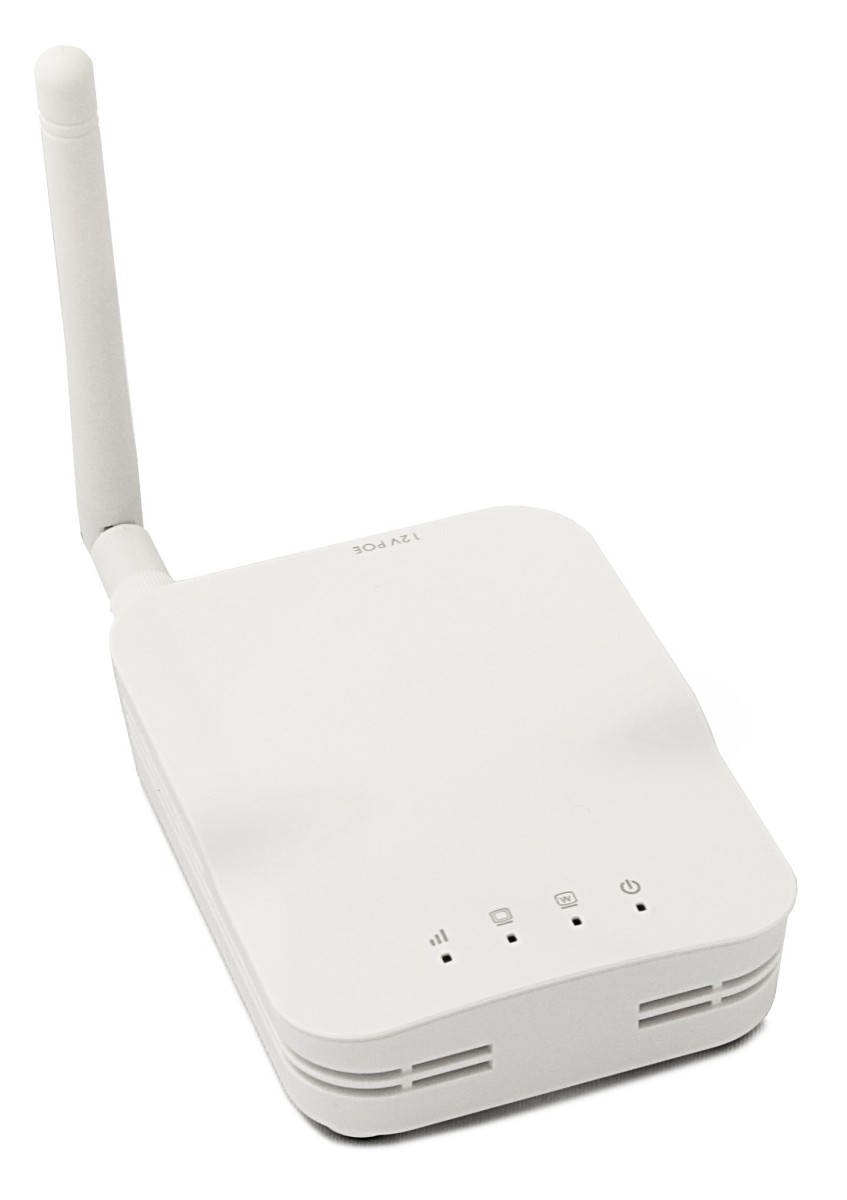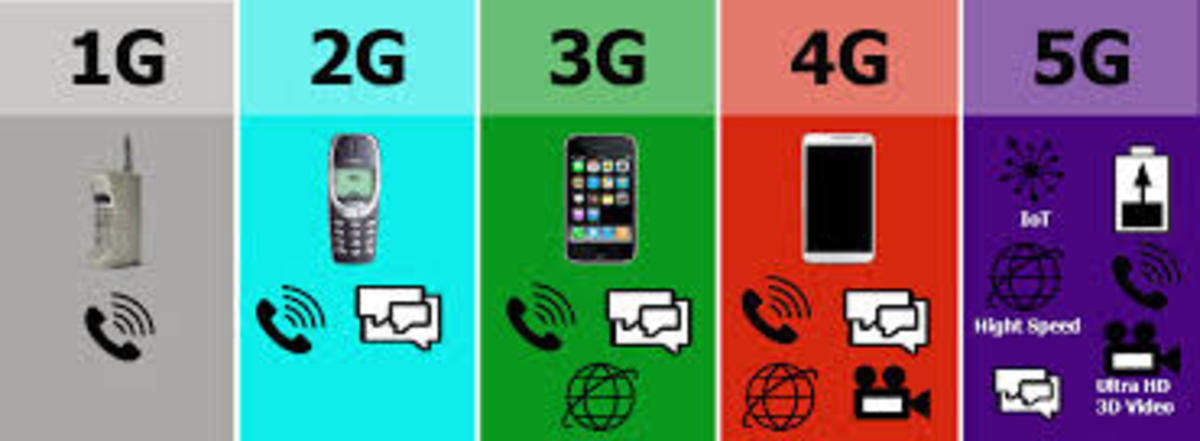Future wireless telecommunications networks (4G and beyond)
Introduction
In the near future, the generation of wireless broadband, numerous other devices and networks will be interconnected and traffic demand will constantly raise, especially with the rapid introduction of the next generations Machine to Machine (M2M) technologies.
Wireless networks have specific requirements that needs to be fulfilled. In this regard, many approaches for introducing intelligence and capacity will be investigated by the research communities [1].
Intelligence shall provide energy and cost-efficient solutions at which a certain application/service/quality level is achieved. Particularly, the introduction of intelligence in heterogeneous network deployments and the cloud radio-access network (RANs) is currently investigated.
Finally, elaboration on emerging enabling technologies for applying intelligence will focus on the recent concepts of software-defined networking (SDN).
The wireless world is heavily calling for the effective management of heterogeneous infrastructures to meet the future Internet requirements [2, 3, 4, 5]. Wireless network operators and vendors are trying to satisfy the growing traffic demand by deploying cells of various sizes (mostly small cells), instead of utilizing only typical macro-base stations (MCNs).
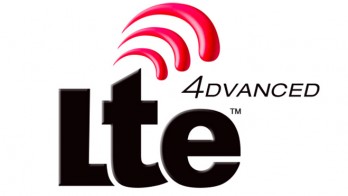
Long Term Evolution (LTE)
Recently, 3GPP Long Term Evolution (LTE) [6] is the most promising standard for the upcoming fourth generation (4G) of mobile wireless communication systems. The innovative aspects included in LTE are a high speed radio interface based on OFDMA/SC-FDMA called Evolved Universal Terrestrial Radio Access (E-UTRA), an all-IP core network called Evolved Packet Core (EPC), and, most importantly, Self-Organized Network (SON) capabilities.
This will open the doors in front of many scientific research leads regarding the future wireless communication systems. Hence, wireless communications have to properly address key challenges and future requirements driven by multiple perspectives of society, economy, users, and operators.
The future networks should be capable of handling the complex context of operations that mainly are characterized by an increase in traffic [7].
What is 3GPP and IEEE?
- And in a result, future wireless communication systems promise positive response to the strong increasing demand of higher data rates and larger capacities.
- Major players in the wireless industry are working together to form and define what 5G wireless will be.
- This takes place through standard committees such as 3GPP and IEEE. Expansion to current wireless standards (e.g. spectrum) and breaking limitations of existing technologies (e.g. MIMO) are popular areas where efforts are dedicated and investment is spent.
- For example, Massive MIMO or Full Dimension MIMO (FD-MIMO), where a large number of antennas is employed at the eNB, is researched and developed to become feasible and rewarding [8].
Your opinion is important
Why do you enjoy writing about technology?
Fundamental Requirements and future capacity
3GPP standardization community has defined a framework for further advancements of E-UTRA and E-UTRAN and the requirements for Advanced E-UTRA and Advanced E-UTRAN based on the ITU-R requirements for IMT-Advanced as well as 3GPP as in [9].
Market performance requirements for future wireless networks
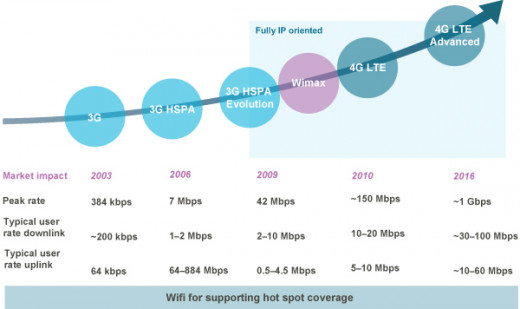
Peak data rate
The system should target downlink peak data rate of 1Gbps and an uplink peak data rate of 500Mbps.
Mobility
System should support mobility across the cellular network for various mobile speeds up to 350km/h.
Latency
Latency is the time needed for system to transient from idle mode to connected mode while providing users with data and voice connectivity. And for the sake of service continuity, its maximum threshold is defined to be 10 ms.
Spectrum efficiency
LTE-Advanced aims to support downlink (8x8antennaconfiguration) peak spectrum efficiency of 30 bps/Hz and uplink (4x4 antenna configuration) peak spectrum Efficiency of 15bps/Hz. These targets are heavily increased (more than doubled) when employing MIMO and MU-MIMO technologies at eNBs.
Enabling Technologies
LTE-A and next generation wireless communications networks are always having major enabling technologies that are recently introduced in favor achieving the performance requirements acquired by standards.
Enhanced Multiple Antenna Technologies
MU-MIMO [10, 11] has become the most effective key enabling technology to achieve IMT-Advanced requirements.
MU-MIMO allocates multiple users in one time-frequency resource to exploit multi-user diversity in the spatial domain, which results in significant gains over SU-MIMO, especially in spatially correlated channels.
In configurations like DL 4 ×2 (four transmit antennas and two receive antennas) and uplink 2 ×4, SU transmission only allows spatially multiplexing a maximum of two streams.
Unlikely, linear MUMIMO schemes allow sending as many as four spatial streams from four transmit antennas, or receiving as many as four spatial streams with four receive antennas, by multiplexing four spatial streams to or from multiple users.
MUMIMO techniques provide large sector throughputs in areas experiencing heavy data traffic from the network point of view.
MU-MIMO 2x2 configuration
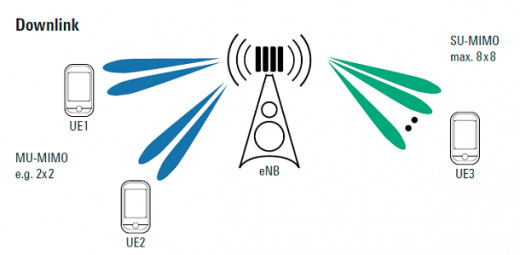
MU-MIMO was already supported in 3GPP LTE Release 8 with a 4 bit codebook user feedback based precoding transmission mode 5 (TM5). Single User MIMO (SU-MIMO) and MU-MIMO use the same codebook for precoding but the codebook has been optimized for SU-MIMO case and therefore is very suboptimal for MU-MIMO since inter-user interference is nit considered and handled accurately. Hence, the performance of stand-alone Rel-8 MU-MIMO is inferior to Rel-8 SU-MIMO transmission mode 4 (TM4) or UE specific reference signal (RS) based beamforming (BF) transmission mode 7 (TM7). This suboptimal codebook selection limits the gains of multi-user transmission and thereby the practical implementation of MU-MIMO systems.
In LTE Release 9, two streams of UE specific RS are supported for MU-MIMO transmission in the downlink dual-layer beamforming (DLBF) transmission mode 8 (TM8). The TM8 has been defined which includes both SU and MU-MIMO transmission capabilities without the need for the UEs to be reconfigured via higher layer signaling when switching between SU and MU mode on the shared data channel.
In LTE-Advanced, Release10, new transmission mode 9 (TM9) is defined allowing seamless switching between SU and MU mode. Configurations with up to 8 x 8 MIMO antennas are to be supported and set of precoding codebooks is extended as well. For configurations with 8 transmit antennas a dual-codebook approach is used and up to four UEs can be scheduled for MU-MIMO.
Hyper-Dense HetNets
Network densification has become an important technology to be employed to increase network capacity, coverage area and hence user throughputs [12]. Small cells are used to offload heavy data traffics on the Macro nodes (MCNs) while they enable better coverage and signal strength for cell edge users. Also, LTE Advanced optimizes small cell performance through features such as “Range Expansion” to ensure that capacity scales with the amount of densification. This is possible with the current advanced interference coordination techniques to eliminate as much as possible, the inter-cell interference on cell edge users.
Network densification using small cell deployments
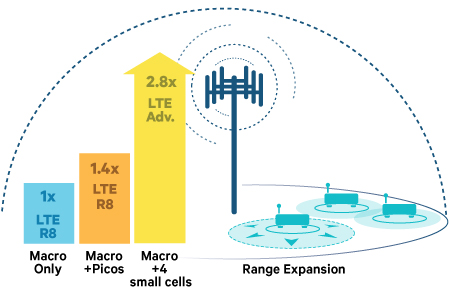
Proximity Based Communications
This is a new novel technology that is introduced specifically for LTE-A systems. It is based on the idea that sometimes the end users have a better chance to directly connect to each other without setting the default path of data traffic to serving eNB.
This enables cell edge users to throw away their restrictions of being long-away from the serving eNBs and hence low levels of received power and higher interference effect will be resulted in. Mobile stations will have an initial phase of neighbor discovery for getting the chance of a direct communication if the other end user is located in proximity of the calling one.
Proximity based device to device communication
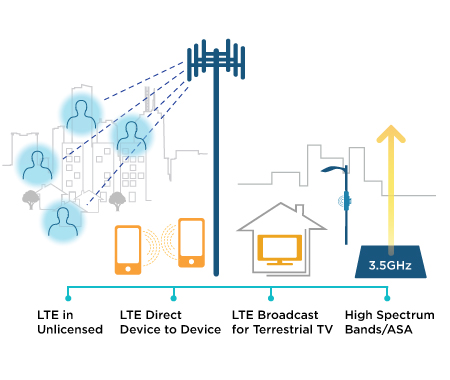
Beyond 4G (LTE-A)
Interoperability of the 5G next generation’s network is main technical issue where there will be enormous size of data traffic specially when activating the internet of things (IoT) technology. A flat IP-based network concept was reviewed, as well as cognitive radio technology to reach the terminal which have artificial intelligence. Then, technological challenges will be identified, focusing on the issues related to security and problems to deal with limited frequency spectrum resources. Subsequently,
Summary and Conclusion
Current user traffics are rising greatly with the technology advances and application developments. Hence, wireless communications networks are required to track that rapid change and the new requirements for next generation technologies in terms of capacity, throughputs and quality of service (QOS).
Several technologies are basically considered the backbone enabling techniques for achieving the target data rates e.g. MIMO and MU-MIMO. Far ahead towards the 5G technology, the interoperability will be the major target since at the time of 5G deployments, there will be thousands of Machine to Machine communications (M2M) to be added to the total capacity of the network as the current advances of the Internet of Things (IoTs) technologies.


